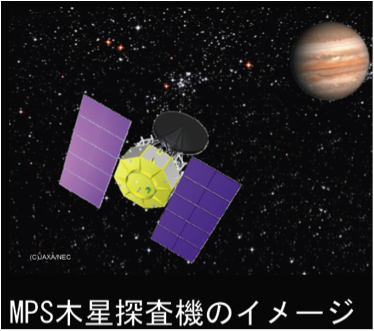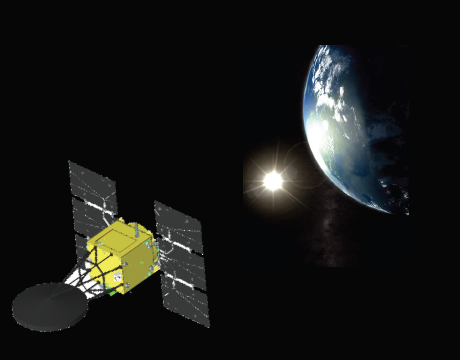Next Generation Deep Space Mission
・Deep Space Exploration by Magnetoplasma Sail
・Demonstration of Magnetoplasma Sail by Small Engineering Satellite
・Energy System for Deep Space Exploration
・Gravitational Wave Observer: DECIGO Path Finder
Outer Planet Exploration by Magnetoplasma Sail
 Fig. Image of Jupiter Explorer by Magnetoplasma Sail
Fig. Image of Jupiter Explorer by Magnetoplasma SailMagnetoplasma Sail (MPS) system needs new technologies, a superconducting coil for space propulsion, laws of thrust and attitude control. Our laboratory cooperates with other laboratories and universities in Japan to research and develop the superconducting coil, a power supply and spacecraft design for a flight model.
Demonstration of Magnetoplasma Sail by Small Engineering Satellite
 Fig. Demonstration Experiment of Magnetoplasma Sail.
Fig. Demonstration Experiment of Magnetoplasma Sail.A demonstration of the magnetoplasma sail by a small engineering satellite of 300 kg class is proposed in order to confirm the performances of 10 mN class magnetoplasma sail by the Plasma Sail Working Group in ISAS/JAXA. This satellite is launched to the earth-escape trajectory by the advanced solid rocket of JAXA. The cooling and excitation of the superconducting coil system and the thrust generation by the plasma injection from the space craft is to be demonstrated.
Energy System for Deep Space Exploration
 Fig. Solar System Escape Mission
Fig. Solar System Escape MissionAt a far location from the sun, solar energy cannot generate enough electric power for spacecraft, and hence other energy systems are required. Spacecraft system consisting of new energy, propulsion as well as onboard equipment is to be studied targeting at a possible solar system exploration or even a solar system escape mission.
Gravitational Wave Detection Mission: DECIGO Path Finder
 Fig. Concept of DECIGO
Fig. Concept of DECIGO
The Japanese formation flying spacecraft (DECIGO, Deci-hertz Interferometer Gravitational Wave Observatory) are studied in collaboration with national astronomical observatory of Japan, kyoto university and so on. DECIGO will have a chance to observe gravitational wave in an orbit around the sun, unveiling the physics at the beginning of the universe. DECIGO consists of three formation flying spacecraft using an interferometry. DECIGO pathfinder will verify required technologies for DECIGO, and DPF is a strong candidate for small scientific satellite of ISAS that will fly around 2017. Our laboratory is responsible for the micro-thruster system for DPF.
Website of the DECIGO project:
http://tamago.mtk.nao.ac.jp/decigo/index_E.html
Website of the LISA project:
http://lisa.nasa.gov/

